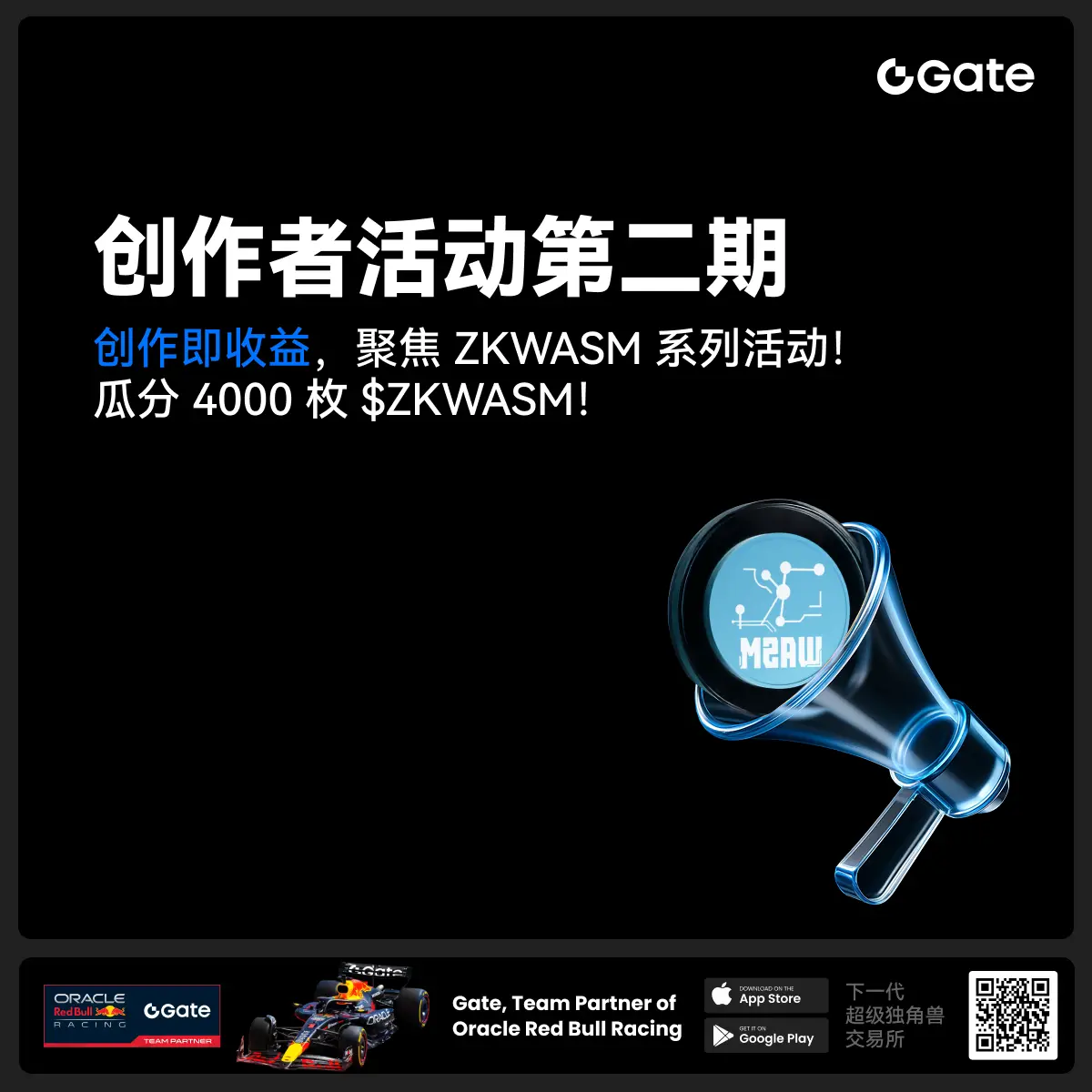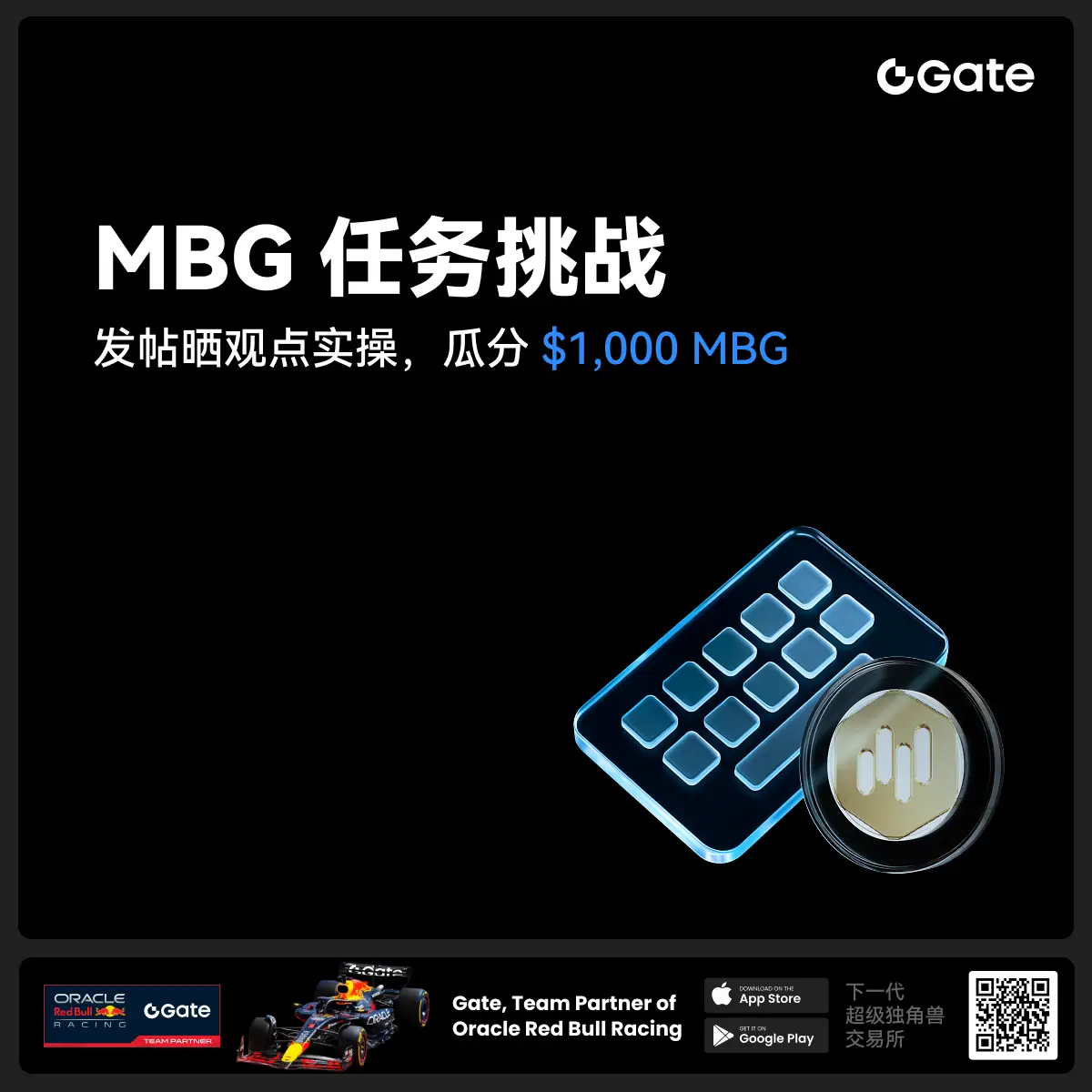- 話題1/3
43772 熱度
845 熱度
708 熱度
146 熱度
150 熱度
- 置頂
- 📢 Gate廣場 #创作者活动第二期# 正式開啓!
聚焦 ZKWASM 系列活動,分享你的觀點,瓜分 4,000 枚 $ZKWASM!
ZKWASM 作爲 zk 公鏈先鋒,正在 Gate 平台重磅推廣!
三大活動聯動上線:Launchpool 認購、CandyDrop 空投、Alpha 專屬交易——不要錯過!
🎨 活動一:發布廣場貼文,贏內容獎勵
📅 時間:7月25日 22:00 - 7月29日 22:00(UTC+8)
📌 參與方式:
- 在 Gate 廣場發布與 ZKWASM 或其三大活動相關的原創內容(不少於 100 字)
- 添加標籤: #创作者活动第二期# #ZKWASM#
- 附本人參與 Launchpool/CandyDrop/Alpha 的截圖(如認購、空投或交易)
🏆 獎勵設置:
- 一等獎(1名):1000 枚 $ZKWASM
- 二等獎(2名):500 枚 $ZKWASM
- 三等獎(10名):100 枚 $ZKWASM
📋 評選標準:內容質量、互動量、項目相關性,附活動參與截圖者優先。
📢 活動二:發推贏傳播力獎勵
📌 參與方式:
- 在 X(推特)發布與 ZKWASM 或三大活動相關的原創內容(不少於 100 字)
- 添加標籤: #ZKWASM # GateSquare
- 填寫登記表 👉 https://www.gate.com/quest
- 📢 Gate廣場 #MBG任务挑战# 發帖贏大獎活動火熱開啓!
想要瓜分1,000枚MBG?現在就來參與,展示你的洞察與實操,成爲MBG推廣達人!
💰️ 本期將評選出20位優質發帖用戶,每人可輕鬆獲得50枚MBG!
如何參與:
1️⃣ 調研MBG項目
對MBG的基本面、社區治理、發展目標、代幣經濟模型等方面進行研究,分享你對項目的深度研究。
2️⃣ 參與並分享真實體驗
參與MBG相關活動(包括CandyDrop、Launchpool或現貨交易),並曬出你的參與截圖、收益圖或實用教程。可以是收益展示、簡明易懂的新手攻略、小竅門,也可以是現貨行情點位分析,內容詳實優先。
3️⃣ 鼓勵帶新互動
如果你的帖子吸引到他人參與活動,或者有好友評論“已參與/已交易”,將大幅提升你的獲獎概率!
MBG熱門活動(帖文需附下列活動連結):
Gate第287期Launchpool:MBG — 質押ETH、MBG即可免費瓜分112,500 MBG,每小時領取獎勵!參與攻略見公告:https://www.gate.com/announcements/article/46230
Gate CandyDrop第55期:CandyDrop x MBG — 通過首次交易、交易MBG、邀請好友註冊交易即可分187,500 MBG!參與攻略見公告:https://www.gate.com/announcements
- 📢 #Gate广场征文活动第三期# 正式啓動!
🎮 本期聚焦:Yooldo Games (ESPORTS)
✍️ 分享獨特見解 + 參與互動推廣,若同步參與 Gate 第 286 期 Launchpool、CandyDrop 或 Alpha 活動,即可獲得任意獎勵資格!
💡 內容創作 + 空投參與 = 雙重加分,大獎候選人就是你!
💰總獎池:4,464 枚 $ESPORTS
🏆 一等獎(1名):964 枚
🥈 二等獎(5名):每人 400 枚
🥉 三等獎(10名):每人 150 枚
🚀 參與方式:
在 Gate廣場發布不少於 300 字的原創文章
添加標籤: #Gate广场征文活动第三期#
每篇文章需 ≥3 個互動(點讚 / 評論 / 轉發)
發布參與 Launchpool / CandyDrop / Alpha 任一活動的截圖,作爲獲獎資格憑證
同步轉發至 X(推特)可增加獲獎概率,標籤:#GateSquare 👉 https://www.gate.com/questionnaire/6907
🎯 雙倍獎勵機會:參與第 286 期 Launchpool!
質押 BTC 或 ESPORTS,瓜分 803,571 枚 $ESPORTS,每小時發放
時間:7 月 21 日 20:00 – 7 月 25 日 20:00(UTC+8)
🧠 寫作方向建議:
Yooldo
- 🎉Gate 2025 上半年社區盛典:內容達人評選投票火熱進行中 🎉
🏆 誰將成爲前十位 #Gate广场# 內容達人?
投票現已開啓,選出你的心頭好
🎁贏取 iPhone 16 Pro Max、限量週邊等好禮!
📅投票截止:8 月 15 日 10:00(UTC+8)
立即投票: https://www.gate.com/activities/community-vote
活動詳情: https://www.gate.com/announcements/article/45974
- 📢 #Gate广场征文活动第二期# 正式啓動!
分享你對 $ERA 項目的獨特觀點,推廣ERA上線活動, 700 $ERA 等你來贏!
💰 獎勵:
一等獎(1名): 100枚 $ERA
二等獎(5名): 每人 60 枚 $ERA
三等獎(10名): 每人 30 枚 $ERA
👉 參與方式:
1.在 Gate廣場發布你對 ERA 項目的獨到見解貼文
2.在貼文中添加標籤: #Gate广场征文活动第二期# ,貼文字數不低於300字
3.將你的文章或觀點同步到X,加上標籤:Gate Square 和 ERA
4.徵文內容涵蓋但不限於以下創作方向:
ERA 項目亮點:作爲區塊鏈基礎設施公司,ERA 擁有哪些核心優勢?
ERA 代幣經濟模型:如何保障代幣的長期價值及生態可持續發展?
參與並推廣 Gate x Caldera (ERA) 生態周活動。點擊查看活動詳情:https://www.gate.com/announcements/article/46169。
歡迎圍繞上述主題,或從其他獨特視角提出您的見解與建議。
⚠️ 活動要求:
原創內容,至少 300 字, 重復或抄襲內容將被淘汰。
不得使用 #Gate广场征文活动第二期# 和 #ERA# 以外的任何標籤。
每篇文章必須獲得 至少3個互動,否則無法獲得獎勵
鼓勵圖文並茂、深度分析,觀點獨到。
⏰ 活動時間:2025年7月20日 17
DeFi監管松綁引爆代幣反彈 頭部項目表現分化
DeFi監管環境改善,頭部項目表現分化
近期,美國監管環境對DeFi領域釋放出積極信號,預示着更爲友好的發展環境即將到來。然而,DeFi市場內部卻呈現出復雜的局面:部分頭部協議表現亮眼,基本面數據強勁;另一些則增長乏力,代幣價格表現不佳。盡管最近DeFi代幣出現快速反彈,但這背後究竟是短期情緒波動還是深層價值驅動仍有待觀察。讓我們聚焦DeFi頭部項目的最新動態與數據表現,分析其中的機遇與挑戰。
監管環境改善:DeFi迎來"創新豁免"框架
美國證券交易委員會近期對DeFi監管態度出現顯著轉變。在一次加密圓桌會議上,SEC主席表示DeFi的基本原則與美國核心價值觀相符,支持加密資產的自我托管。他強調區塊鏈技術實現了無需中介的金融交易,監管部門不應阻礙此類創新。
值得注意的是,主席首次透露已指示研究針對DeFi平台的"創新豁免"政策框架,旨在加速推動鏈上產品和服務進入市場。他還明確表示,開發自我托管或注重隱私軟件的開發者不應僅因發布代碼而承擔法律責任,並提到挖礦和質押本身不構成證券交易。
SEC加密任務組負責人也表達了支持立場,強調不應因他人使用代碼而追究發布者責任,但同時警示中心化實體不得借"去中心化"標籤規避監管。
這些表態被市場視爲重大利好,引發DeFi代幣價格大幅漲。若"創新豁免"框架得以實施,有望爲美國DeFi項目發展營造更寬松明確的監管環境。
數據分析:TVL增長乏力,代幣反彈強勁
在監管利好消息釋出後,DeFi類代幣普遍出現漲,尤其是頭部項目漲幅顯著。然而,這是否僅是短期市場反應還是行業自然增長結果?我們對前20名DeFi協議的近半年數據進行了分析。
總體而言,這些頭部DeFi協議在2025年上半年的TVL增長並不明顯。7個協議TVL出現下滑,5個增長不超過5%。增長最快的是貝萊德推出的RWA項目BUIDL。傳統DeFi協議中,Aave表現最佳,TVL突破260億美元創歷史新高,上半年增長超60億美元。Sky系的Spark則增長了72.97%。
值得注意的是,波場生態的JustLend TVL在上半年下降了39.82%,成爲降幅最大的頭部協議。其他熱門協議如Sky、Lido、EigenLayer、Uniswap等也出現不同程度下滑。
代幣價格方面,前20名DeFi協議的代幣在2025年上半年平均最大回撤達57%。盡管近期市場回暖帶來反彈,大多數協議代幣仍未回到年初水平。僅SKY的治理代幣MKR相比1月1日漲44.8%,AAVE勉強回到年初價格。總體上,這些代幣平均較年初下跌24%。
然而,這些DeFi項目的代幣近期普遍出現大幅反彈,平均低點反彈漲幅約95.59%。ether.fi、Sky、Aave、EigenLayer、Pendle等幾個代幣反彈幅度超150%。從走勢來看,這些代幣的近期低點集中在4月7日,與整體加密市場走勢相似,但反彈力度普遍優於其他類型代幣。
值得注意的是,代幣價格走勢與DeFi協議TVL表現似乎並無直接關聯。
頭部項目表現分化
在衆多DeFi項目中,一些頭部項目的表現尤爲引人注目:
Aave作爲龍頭項目,上半年數據表現亮眼,多次突破歷史新高,並拓展至18條公鏈。爲提振代幣價格,Aave社區推出"Aavenomics"提案,包括每週百萬美元代幣回購等措施。Aave雖然借貸利率不高,但深度雄厚,吸引了不少大戶。總體而言,Aave在基本面和市場表現方面均實現漲,仍是DeFi協議發展的標杆。
Uniswap在2025年正式上線V4版本,引入更多靈活的自定義邏輯並顯著降低Gas費用。Unichain的上線進一步擴展了其在DeFi生態的競爭力。盡管上半年TVL有所下滑,但主要受以太坊價格下跌影響,ETH質押量相較年初有所上升。Unichain快速佔領市場,已成爲Uniswap上TVL排名第二的公鏈。
Sky(原MakerDAO)經歷全面品牌升級後,TVL出現下滑,但生態內Spark協議在RWA方向展現新潛力。兩個協議TVL合計超110億美元,排名前三。MKR代幣價格表現亮眼,從最低800美元漲至2100美元,漲幅超170%。然而,復雜的升級計劃使市場難以形成簡單認知,不利於傳播。
EigenLayer創新的"再質押"概念引發關注,TVL經歷爆發式增長後一度回落,但從4月開始重新進入增長週期,兩個月內從70億美元增至124億美元,增幅77%。市場似乎正在重新定義再質押的價值。
Lido作爲流動性質押龍頭,曾憑藉stETH佔據市場主導地位,TVL一度接近400億美元。然而,隨着以太坊L2快速增長,過度依賴以太坊主網的Lido(佔比超99%)呈現頹勢,TVL持續下滑。其代幣近期反彈幅度不及其他DeFi代幣。盡管仍排名第二,但如何快速適應更多市場成爲Lido保持領先地位的關鍵。
監管環境的改善爲美國DeFi市場注入活力,有望緩解長期困擾項目方的不確定性。數據趨勢顯示,DeFi發展動能日益獨立,甚至開始反哺底層公鏈價值。未來,監管明確化可能吸引更多傳統金融資本進入DeFi領域。同時,傳統金融巨頭推出DeFi產品的嘗試,預示着更廣闊的融合前景和更激烈的市場競爭。這場由監管松綁開啓的新局面,或將成爲DeFi走向成熟、與傳統金融深度交融的起點。